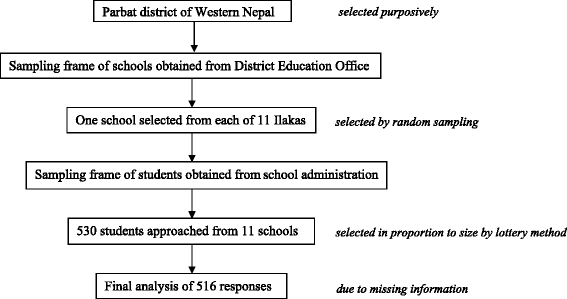Breast cancer literacy among higher secondary students: results from a cross-sectional study in Western Nepal
- PMID: 26887650
- PMCID: PMC4758038
- DOI: 10.1186/s12885-016-2166-8
Breast cancer literacy among higher secondary students: results from a cross-sectional study in Western Nepal
Abstract
Background: Being the most common cancer among women worldwide, it is vital to be well-aware of breast cancer risk factors, symptoms and curability. However, few studies have reported breast cancer literacy in students using a validated instrument.
Methods: A cross-sectional study was conducted among students of grades 11 and 12 from eleven higher secondary schools, one selected randomly from each ilaka of Parbat district. Questionnaire with modified Comprehensive Breast Cancer Knowledge Test was self-administered to 516 students. Knowledge score was categorized into two categories: 'good knowledge' and 'poor knowledge' taking median score as the cut-off. Chi-square test was used to determine difference in knowledge by socio-demographic factors, including gender.
Results: Only 4.8% of the students responded correctly to at least half of the items, and 1.4% did not respond correctly to any of the items on risk factors and curability. Physical exercise was identified as a protective factor of breast cancer by 62.4% of the students. Presence of noncancerous breast lumps (56.6%) and being overweight (36.4%) were recognized as the risk factors. Knowledge of lumpectomy and radiation therapy for treatment of breast cancer was reported by 42.8% of students, while only 39.0% were aware of the availability of treatment therapies other than mastectomy. Males were significantly better informed than females (χ(2) = 4.02, p = 0.045). Pain in the breast (23.3 %), change in the shape of the breast (20.0%) and discharge of pus (14.1%) were the three most commonly recognized symptoms. Nearly one in two (47.1%) students indicated that the school curriculum inadequately informed them on breast cancer.
Conclusion: Our study demonstrates poor knowledge on breast cancer risk factors, symptoms and curability among higher secondary school students in Western Nepal. Still, several myths regarding breast cancer persist. Half of the students had the perception that school curriculum inadequately informed them on breast cancer. Future studies should aim at the measures necessary to address the inadequate knowledge, along with the perceived gap in school curriculum.
Figures
References
-
- International Agency for Research on Cancer . World Cancer Report 2014. Geneva: World Health Organization; 2014.
-
- Moore MA, Ariyaratne Y, Badar F, Bhurgri Y, Datta K, Mathew A, et al. Cancer epidemiology in South Asia-past, present and future. Asian Pac J Cancer Prev. 2010;11(Suppl 2):49–66. - PubMed
-
- The University of Sheffield. South Asian women should no longer be considered at low risk of breast cancer. 2013. http://www.sheffield.ac.uk/news/nr/breast-cancer-risk-1.280243. Accessed 21 January 2016.
MeSH terms
LinkOut - more resources
Full Text Sources
Other Literature Sources
Medical
Miscellaneous



